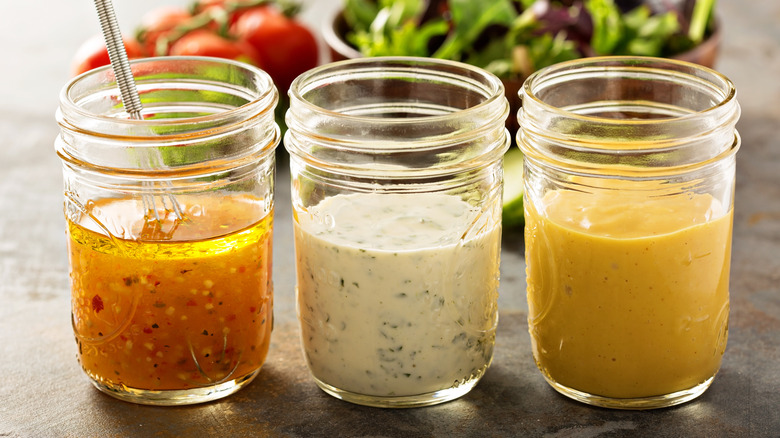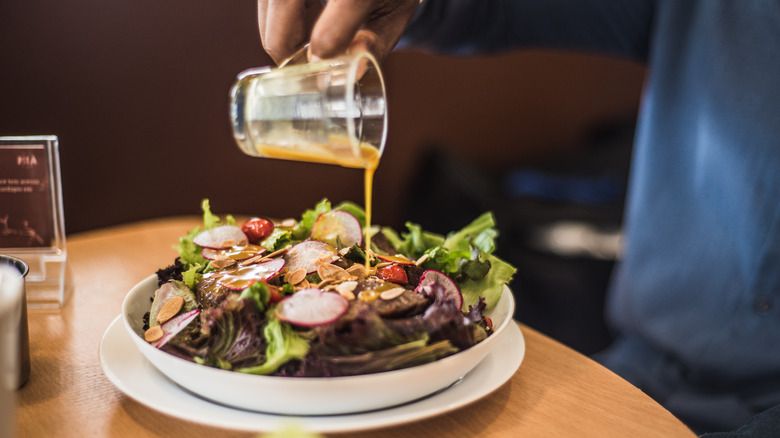The Simple Trick To Make Salad Dressing In A Flash
Tired of being beholden to bottled, ready-made salad dressings? Sure, you could buy a brand and flavor that comes close to what you want and doctor it at home, but nothing beats making something entirely to your preference from scratch. Salad dressings, especially vinaigrettes, are one of the easiest, low-stakes preparations that leave you wondering why you ever got the supermarket stuff in the first place.
According to famed culinary author Michael Ruhlman in his book "Ratio," the basic ratio for vinaigrettes is 3:1, or three parts oil to one part vinegar. While this is pretty easily done with measuring cups and whisks, you can skip several cleaning steps by making and shaking salad dressings in a mason jar. And if you're going to use the same mason jar over and over again to make vinaigrettes? Skip yet another step and mark the ratio levels on the jar that you regularly use. You can mark the three-to-one levels with a permanent marker or dishwasher-safe tape. With just one mason jar, you can use it to measure your ingredients and shake it all up, then use it as a pouring vessel, and later to store your precious homemade salad dressing. Talk about multi-purpose!
Keep the ratio but change up the fat and acid
This basic ratio of salad dressing means that you have a template to use virtually any edible fats and edible kinds of vinegar or acids that you think will go well together. Start with extra virgin olive oil and a good quality wine vinegar (red or white will both work), season with a touch of salt and whatever herbs or spices you like, then shake and pour. Once you are confident with this combination, you can experiment with other fats and acids. Nutty oils like almond or walnut oil will add a savory depth of flavor while grapeseed and rapeseed oils provide a more neutral background for flavored vinegars to shine.
Acids are where the bulk of the flavor comes from, as they add that memorable bright high note to salad dressings. So even though the ratio calls for less vinegar, make sure it is a flavor that you really enjoy. Balsamic vinegar is especially popular for Mediterranean-style vinaigrettes, but you can try different kinds of vinegar like fruit vinegar (think apple and pomegranate), or even other acidic elements. Try citrus juices, like grapefruit, or the kitchen workhorse, lemon.
Even though homemade vinaigrette can last for more than a week, it is possible that its emulsion might break at some point. If that happens, don't worry — simply shake it all back up to redistribute the ingredients.
Add more for ideas galore
While the aforementioned ratio is useful as a base, you can definitely stretch it in either direction. Use more acid if you are using a particularly rich fat like duck fat, or more fat to balance out a very sharp acid like distilled white vinegar. Just don't stray too far from those handy marks you made on the mason jar — they're still a good guide for eyeballing experimental quantities!
Think of other flavors you can incorporate into your salad dressing. Ketchup? Soy sauce? Different kinds of cheeses and mustards? These flavors show up in popular salad dressings around the world. Tahini is also a favorite, and while surprising, even leftover jam can spruce up a salad dressing. You can incorporate finely chopped alliums like shallots and garlic — and add in various fresh herbs and dried spices, like parsley leaves or mustard seeds.
Just keep one thing in mind. Remember not to make the dressing too chunky or strong to overwhelm the salad; with a little experience, you can just make another mark on the jar to indicate how many additional ingredients you can ideally work in the dressing before going overboard.


